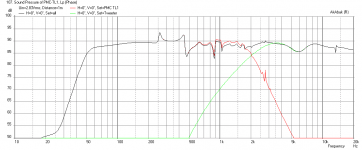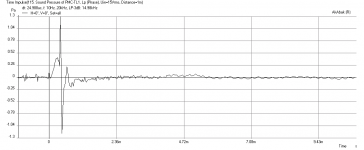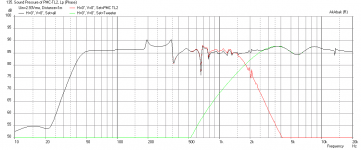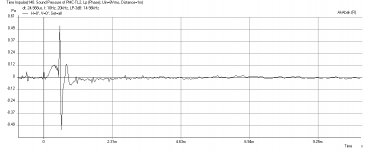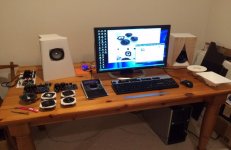I read your thread on how you selected the Satori. Indeed looks like it could be my next mid bass for a ref monitor. Great questions and explanations in there. My current RS225 based monitor is a largish 24liters. I can see why you were trying to keep it at 15liters.
I saw some discussions of miniDSP and transparency vs passive crossovers - what is your impression of the transparency of the base 2x4 miniDSP as far as transparency? I have done the play straight thru test listened and measured and could hear no reduction in sound quality. But then maybe I just don't know what I have not heard. Then saw link to miniDSP 10x10HD review. That unit sounds like it might make a great upgrade for higher quality 4 way system with subs. At $600 doesn't sound so expensive for all that you get including ability to do arbitrary 10x10 crossbar matrix.
Music in the Round #64 Page 2 | Stereophile.com
Yeah small size was one of my criteria and my current satori/rs28f is closer to 10L. I could probably go a little deeper with the box, but it seems to work well with only about 5DB of LT boosting. I want to try a TL but that will be a slightly bigger box. did some quick calculations and I think I can do a satori constant area TL in about a 400 x 240 x 300 mm (HWD) box which is not so bad.
So far I am not finding the miniDSP the limiting factor. I am certain at some point I might tweak the system to a point where it might show its limits, but so far I am sufficiently happy with its performance. And miniDSP + class D is a potent combination. classD might not work as well with a passive crossover with big caps and coils (damping factor from what I have read). Maybe with a top class tube or classA amp the passive might be a little more transparent, but it would have to be top end caps,coils,amps. I don't think that the DSP inherently is bad since almost all music produced in the last 10 years is run through digital filters, mixers and effects to produce these "transparent" recordings. I don't think the actual DSP chip will have much effect on the final sound as long as there is enough bit depth. The algorithms and AD/DA converts might though. I am not really convinced on high dollar DSP boxes yet. Might be just as well off buying 2 miniDSPs to get 8 channels to do a 4way.
If I would consider a DSP upgrade, I would probably focus more on a chip which could allow FIR filtering and more advanced programming beyond the simple IIR and biquads available on the miniDSP style chips. And I think I would want to try a pass Aleph30 on the tweeter and bridge the TPA3116 to 100watts for the midbass or some hypex classD amps before changing the miniDSP
Last edited:
Good to hear that you think the base miniDSP is not the limiting factor. I think you have better critical listening ears than many people so that means a lot. I bought two 2x4 miniDSP for stereo 4 way capability too. You have to program them separately but that is not that big a deal. FIR is really the next upgrade I suppose given the perfect response and IR pulses we have seen come out of work by Barleywater and Wesasyo.
I can take a crack at designing a TL for the Satori - what is your desired bass extension and are you more concerned about smooth rolloff for lower GD?
I can take a crack at designing a TL for the Satori - what is your desired bass extension and are you more concerned about smooth rolloff for lower GD?
Thanks for offer to help with a satori TL XRK! I think flat extension to 40hz would be good. Or 45hz if you feel that is less of a stretch. I like bass which is controlled and accurate. I also have a Yamaha sw10 subwoofer which can cover the really low bass. Smooth roll off would be nice if possible.
Not sure if constant area TL, or fully stuffed TL or tapered TL would work best with the Satori. PMC maybe still uses constant area or maybe a very gentle taper.
Sent from my K00R using Tapatalk
Not sure if constant area TL, or fully stuffed TL or tapered TL would work best with the Satori. PMC maybe still uses constant area or maybe a very gentle taper.
Sent from my K00R using Tapatalk
I did a quick TL design last night based on my current front baffle. 200x310mm internal dimensions, I think a 200x60mm constant TL area with 5 bends would give me about 1.51meter length. As a starting point.
Sent from my K00R using Tapatalk
Sent from my K00R using Tapatalk
Here is my base tapered TL simulation for a 2-way using the dual 5FE120's and an RS28F with a Harsch XO at 2100Hz. I just figured out how to model the Harsch XO in Akabak. As you can see, it has the characteristic dip below the woofer-only trace. The delay seems a bit wierd as I need to use 0.40 ms to make it work when according to theory it should be 27 uSec. Max SPL is predicted to be 104dB at 15v.
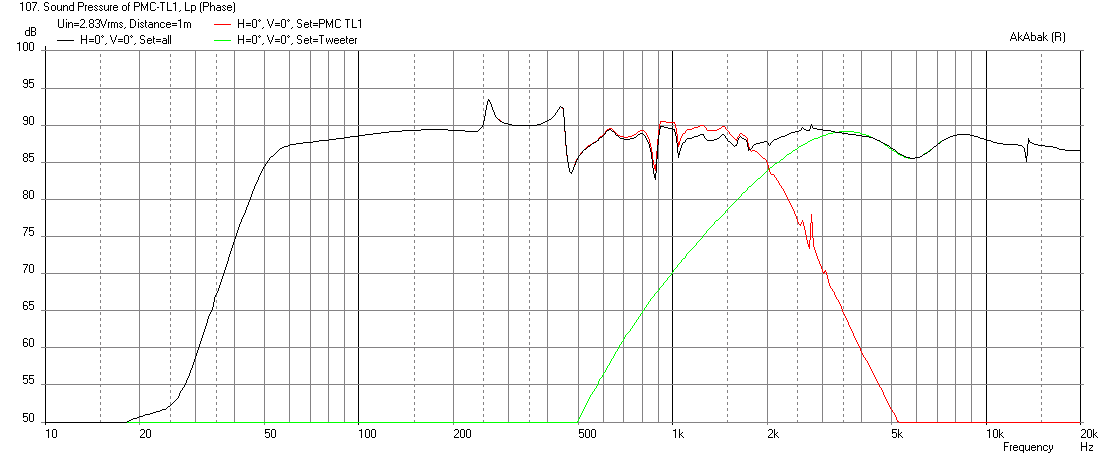
Here is the corresponding impulse response:
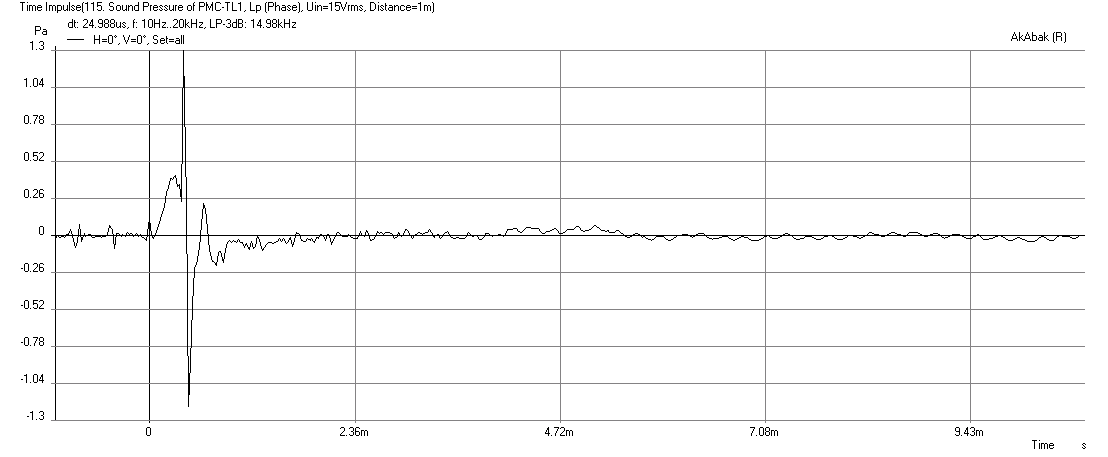
Now that I think I have a fairly good model, I can move onto the Satori in this. Where do you think you would like to XO the Satori with the RS28F?

Here is the corresponding impulse response:

Now that I think I have a fairly good model, I can move onto the Satori in this. Where do you think you would like to XO the Satori with the RS28F?
Attachments
Satori TL + RS28F
Here is a very rough cut at a sim for the Satori MW16P-4 in a TL similar in shape to what I have in post 1 but scaled up to be about 17.3in tall (internal, no thickness of wood added), 7.0in wide (internal) with the first channel 5.75in deep, the second one at 3.84in deep, and the last one at 1.92in deep. So the depth is 11.5in (internal no wood thickness yet). For 0.5in thick EVA or plywood add 2in to depth and 1in to height and 1in to width for a 18.3in tall x 13.5in deep x 8in wide speaker cabinet. The driver is 3in deep so the 5.75in deep channel works well and allows room for absorbent padding behind the driver. Based on 17.3in height, the TL length is about 1.31m. If you add another segment to have it front firing that would make it 1.6m long and that would extend bass lower but at expense of SPL. Probably down to 83-84dB or so. So I think 86dB sounds much better and is compatible with low power class D TPA3116 amps.
Here is the predicted response (the smaller peaks will probably be attenuated flat with felt lining and some stuffing which is not properly accounted for here). The sensitivity after baffle step losses is 86dB at 2.83v and the f3 is 42Hz. Here, the Harsch XO point is 1700Hz (selected based on what Parts Express recommend as XO point):

Here is the corresponding impulse response:
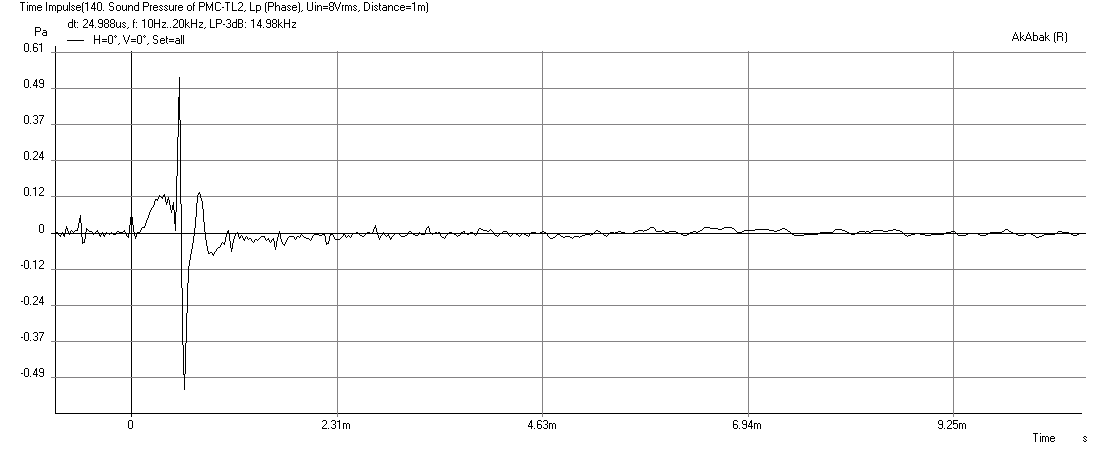
There is a problem though, this design needs to be reworked from scratch as it doesn't load the cone properly and xmax is reached at only 8v drive, thus limiting max SPL. But it gives a good starting point for tweaking.
Here is a very rough cut at a sim for the Satori MW16P-4 in a TL similar in shape to what I have in post 1 but scaled up to be about 17.3in tall (internal, no thickness of wood added), 7.0in wide (internal) with the first channel 5.75in deep, the second one at 3.84in deep, and the last one at 1.92in deep. So the depth is 11.5in (internal no wood thickness yet). For 0.5in thick EVA or plywood add 2in to depth and 1in to height and 1in to width for a 18.3in tall x 13.5in deep x 8in wide speaker cabinet. The driver is 3in deep so the 5.75in deep channel works well and allows room for absorbent padding behind the driver. Based on 17.3in height, the TL length is about 1.31m. If you add another segment to have it front firing that would make it 1.6m long and that would extend bass lower but at expense of SPL. Probably down to 83-84dB or so. So I think 86dB sounds much better and is compatible with low power class D TPA3116 amps.
Here is the predicted response (the smaller peaks will probably be attenuated flat with felt lining and some stuffing which is not properly accounted for here). The sensitivity after baffle step losses is 86dB at 2.83v and the f3 is 42Hz. Here, the Harsch XO point is 1700Hz (selected based on what Parts Express recommend as XO point):

Here is the corresponding impulse response:

There is a problem though, this design needs to be reworked from scratch as it doesn't load the cone properly and xmax is reached at only 8v drive, thus limiting max SPL. But it gives a good starting point for tweaking.
Attachments
Last edited:
Works great as desktop speaker
I am using the F105WK TL side by side with my PA130-8 XKi as desktop speakers to compare. They are powered with a "Lunch Money Amp" - TDA7297 and 12v wall wart and sound pretty good together. Similar sensitivities and can get louder than I need with a 12w amp. Trying to decide which way to go for the stereo pair. I might just keep running it asymmetric like this for while. The PA130-8 is the Daytonator diy coaxial that I made. Both seem to hit the highs quite well and have rich full sound down to 60Hz with circa 88dB sensitivity.
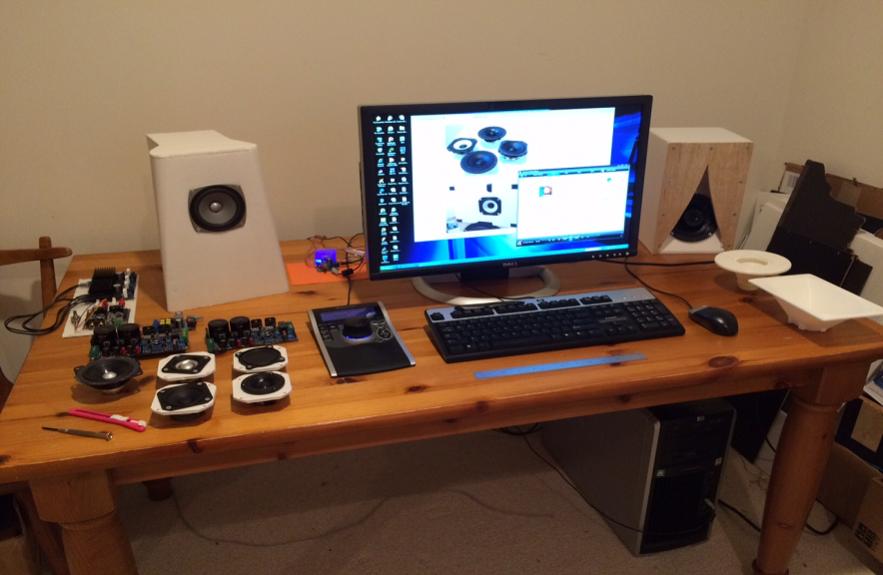
I am using the F105WK TL side by side with my PA130-8 XKi as desktop speakers to compare. They are powered with a "Lunch Money Amp" - TDA7297 and 12v wall wart and sound pretty good together. Similar sensitivities and can get louder than I need with a 12w amp. Trying to decide which way to go for the stereo pair. I might just keep running it asymmetric like this for while. The PA130-8 is the Daytonator diy coaxial that I made. Both seem to hit the highs quite well and have rich full sound down to 60Hz with circa 88dB sensitivity.

Attachments
From the above photo, if you simply replace the right side speaker with the CHN-70 Karlsonator (more info here), you get this sound of classical guitar which I thought so remarkable, I had to share.
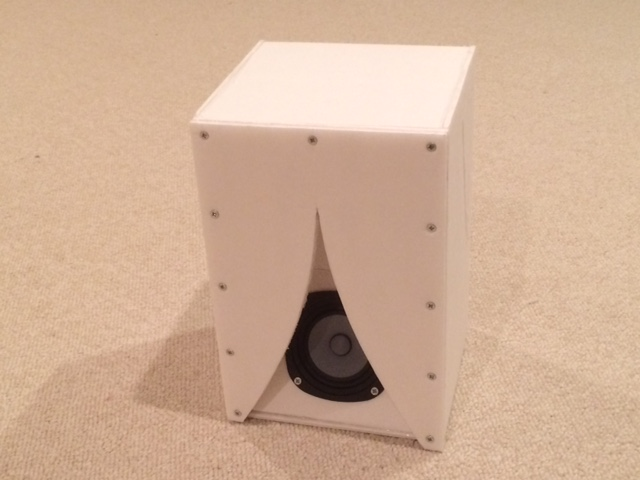
The pair is quite an odd couple but amazingly work well together. Quite the nice sounding desktop speakers. Right now powered by a TDA7297 class AB amp.
Change extension from .asc to .mp3 to listen.

The pair is quite an odd couple but amazingly work well together. Quite the nice sounding desktop speakers. Right now powered by a TDA7297 class AB amp.
Change extension from .asc to .mp3 to listen.
Attachments
Last edited:
- Status
- Not open for further replies.
- Home
- Loudspeakers
- Full Range
- FF105WK TL for Desktop/Bookshelf
